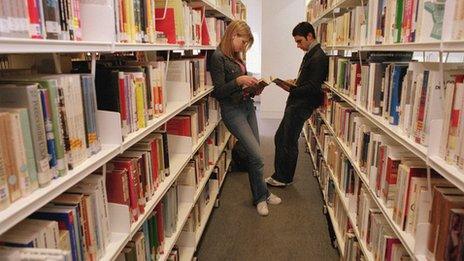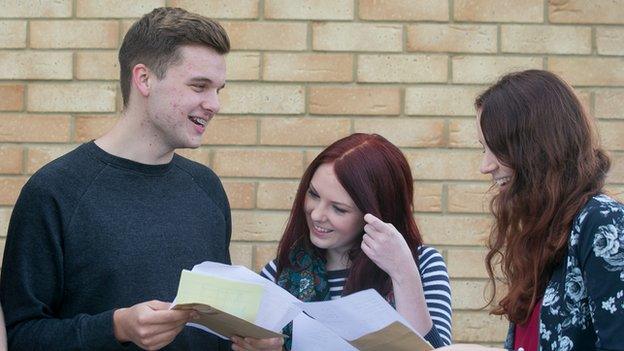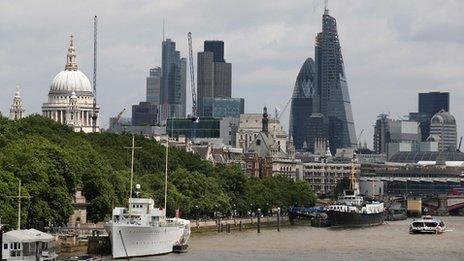Women take more places in rising university numbers
- Published

The gender gap, with many more women than men entering university, is wider than ever before
The number of UK university entrants passed 500,000 for the first time in 2014, with women a third more likely to enter higher education than men, Ucas admissions service figures show.
Among 18-year-olds, 34% of women were allocated university places, compared with 26% of men, the widest ever gap.
The gap is more than 50% in a quarter of parliamentary constituencies.
The admissions figures also suggest more students with lower grades are getting places at top universities.
About a third of applicants getting BBB grades got places in "higher tariff" universities, about twice as many as in 2011.
There was also an increase in universities making unconditional offers to applicants they most want to recruit.
Wide variations
This year's university admissions figures show a rising tide of more applications, more offers and more accepted places.
Some 512,400 people secured places in UK universities through Ucas applications in 2014, up nearly 17,000. The number of UK students rose 3% to 447,500, and there were increases in the number of students from outside the UK.
But within the overall rising numbers there were big variations.

The gap between entry rates for rich and poor students has narrowed
The Ucas figures show women are much more likely to enter university than men. This applies to both rich and poor families and across almost all regions.
According to Ucas, two decades ago there was no gender gap, but this has now become one of the most distinctive features of applications.
While 26% of men go to university, in some constituencies the male entry rates are much lower - in Bristol South it is only 11% of 18-year-olds.
In contrast there are constituencies where more than half of female school leavers go straight to university.
Ucas says the gender gap in entry rates is the equivalent of 32,000 "missing" male students.
Regional differences
While the gap between male and female is at its widest ever, the gap between rich and poor is at its lowest.
Record numbers of disadvantaged students are getting places in higher education, rising by 11% compared with last year.
These students were particularly likely to enter with BTec qualifications, rather than A-levels.
But the figures also suggest poorer pupils are still significantly less likely to attend the most selective universities than their wealthier peers, according to the charity Teach First.
"If we want to see the access gap become a thing of the past across higher education, it is vital that universities allocate more of their access budgets to outreach programmes with schools serving low-income communities, and that schools are provided with statutory guidance on how to provide specific advice for pupils thinking about applying to more selective and elite universities," said Teach First founder Brett Wigdortz.

For young applicants in England, 85% were accepted for a university place this year
But regional differences remain across the UK. Young people in London and Northern Ireland are the most likely to enter university - those in Wales and the South West of England have the lowest entry rates.
There are even lower figures for Scotland, but these are incomplete because Ucas does not cover admissions for all Scottish higher education.
There are even wider local differences - with some places having average entry rates below 15% while others are above 50%.
Buyers' market
The admissions figures also show the growing competition between universities to attract students.
Universities are making more offers than ever before, 1.8 million this year, with students with high predicted grades getting four or five offers.
Students without A or A* grades at A-level were more likely this year to have got into a selective "higher tariff" university. For students with three B grades, 35% got places into a top-tier university, compared with 32% last year and 17% in 2011.
Among students with BBC grades, 15% got places at higher tariff universities, compared with 6% in 2011.
For applicants with DDE grades, 12% got into "medium tariff" universities and 58% found a place at a "lower tariff" university.
Across all types of university, the Ucas figures show that 85% of 18-year-old applicants from England were accepted for a place somewhere.
Mary Curnock Cook, Ucas chief executive, said the increase in university entrance by disadvantaged students was a "stunning account of social change".
"These trends are pushing the difference in entry rates between rich and poor to historic lows," she said.
Nicola Dandridge, chief executive of Universities UK, said the rising number of applications represented the end of the volatility that followed the increase in tuition fees.
"It suggests a return to stability in university applications following the changes and dip in 2012," she said.
Universities Minister Greg Clark said: "For the first time ever over half a million students have entered higher education, with entry rates for students from disadvantaged backgrounds increasing by over 10% to its highest ever levels across the UK.
"Higher education is a transformational experience and that is why we are the first government to remove the limit on student numbers lifting the cap on aspiration."
- Published15 August 2014

- Published24 October 2013

- Published11 September 2014